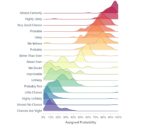
by tyler garrett | May 23, 2025 | Data Visual
In the age of advanced analytics and machine learning, regression models have become indispensable tools guiding business leaders toward smarter, data-driven decisions. Yet, even the most sophisticated models require rigorous scrutiny and ongoing evaluation to ensure accuracy and effectiveness. Visual diagnostics—a powerful technique leveraging the inherent human ability to discern patterns and anomalies—can significantly enhance your understanding of model performance, offering clear insights to even non-technical stakeholders. In this article, we’ll discuss effective visual diagnostics methods for regression model evaluation, empowering you to make accurate, strategic, and timely decisions with reliability. Armed with these practical visualization techniques, professionals across industries can confidently identify model shortcomings, fine-tune predictive analytics workflows, and optimize data-driven insights.
Why Visual Diagnostics Matter in Regression Evaluation
Regression remains one of the most popular analytics approaches employed by businesses today, used widely to manage risk, forecast demand, or even in predicting client churn. Still, numerical output alone rarely provides the full narrative required to fully trust and strategically act upon valuable model insights. Visual diagnostics bridge this gap precisely, delivering clearer perspectives to decision-makers and stakeholders engaged in interpreting results. Effective visual diagnostics accelerate the identification of pitfalls, enhancing transparency and improving the communication of quantitative insights to diverse audiences.
Data visualization doesn’t merely summarize results; it helps strategically pinpoint model weaknesses. These graphical diagnostics flow naturally within standard analytics workflows, allowing businesses to detect influential points, anomalies, heteroscedasticity (unequal variability), autocorrelation, and potential biases inherent in their models. By making model evaluation visually intuitive, stakeholders—without extensive statistical or coding expertise—can confidently address data challenges and drive innovations forward. Partnering with specialized data visualization consulting services ensures an enterprise-wide comprehension of analytical outcomes, significantly improving trust in predictive analytics initiatives.
Key Visual Diagnostics Techniques for Regression Models
Residual Plots for Understanding Model Errors
A foundational visual diagnostic method is creating residual plots—displaying the difference between actual and predicted values plotted against predicted values or explanatory variables. Residual plots instantly convey if essential regression assumptions of linearity and homoscedasticity are being respected, making them immensely useful for straightforward statistical confirmation. Patterns emerging in such plots, such as a clear curvature or funnel-shaped dispersion patterns, directly signal model deficiencies like non-linearity or heteroscedasticity. Quickly addressing these visual cues allows data scientists or decision-makers to iterate rapidly, minimizing predictive bias and variance.
For business teams new to advanced statistical evaluation, residual plots offer an intuitive bridge to enhancing quantitative clarity. Unlike complex statistical diagnostics, residual plots visually uncover areas a model struggles to predict accurately, allowing strategic recalibration of model structures, feature engineering practices, or revisiting fundamental data modeling principles.
QQ-Plots and Histograms for Assessing Normality of Residuals
Normality in residual distribution is a critical assumption in regression analysis, influencing conclusions drawn from predictive models. Quantile-Quantile (QQ) plots and histograms serve as essential diagnostics presenting a straightforward way to verify normality visually. QQ-plots compare observed residual quantiles to a theoretical normal distribution, vividly highlighting deviations via curves, tails, or anomalies. A well-aligned QQ-plot communicates normal residual distribution clearly, ensuring validity in hypothesis testing and model accuracy.
It’s essential that strategic decision makers are aware of normality assumptions to interpret results critically. Visualization methods such as histograms and QQ-plots democratize analytics, enabling non-statistical experts to identify deviations from normality visually rather than relying solely on statistical jargon. By ensuring normality, businesses solidify their confidence in regression-driven decisions, mitigating risks that could arise from unverified assumptions.
Leverage and Influence Plots to Detect Influential Observations
In regression analytics, influential observations or outliers can disproportionately skew model results, impacting key insights and strategic decisions. Leverage and influence plots, including Cook’s distance plots, provide tailored visual diagnostics addressing this significant risk. Such visual tools intuitively highlight data points significantly impacting regression coefficients or influencing predictive model outcomes, dramatically easing the task of outlier identification and management.
Strategically addressing influential observations ensures regression analysis reliability and consistency. Businesses managing large databases (big data vs. small data) appreciate how quickly visually intuitive leverage plots facilitate prompt anomaly detection. Identifying and carefully evaluating influential observations helps optimize regression models across predictive analytics tasks such as demand forecasting, churn prediction, or revenue projection, safeguarding analytical integrity and boosting result confidence.
Advanced Visualization Techniques for Enhanced Diagnostics
Partial Regression and Component-Plus-Residual Plots
While standard diagnostics offer critical foundational insights, advanced visualization methods such as partial regression and component-plus-residual (CR) plots deepen understandings by visually assessing specific feature contributions. Partial regression plots help enterprise decision-makers visually explore the individual relationship between each explanatory variable and target outcomes, isolating potential biases or model inadequacies tied to specific variables. Leveraging these visual diagnostics, companies can quickly prioritize feature engineering or variables refinement strategies, enhancing data-driven decisions significantly.
Component-plus-residual (CR) plots extend further by incorporating partial fits into analysis, helping pinpoint deviations, curvatures, or nonlinearities affecting a regression’s predictive accuracy. CR plots empower strategic leaders to implement targeted model adjustments effectively, ensuring continuous improvement in predictive performance. Innovative companies seeking analytics optimization strategies increasingly adopt these advanced visualization practices, reaping considerable benefits internally from crystal-clear, actionable diagnostic insights.
Utilizing Interactive Data Visualization Tools for Regression Diagnostics
Static visualizations offer tremendous possibilities, yet dynamic, interactive data visualization tools substantially amplify diagnostic capabilities by empowering stakeholders to explore regression model evaluations intimately. By leveraging popular interactive visualization products such as Tableau, Power BI, or Looker, professionals can transform static regression model results into strategic business assets. Explore this detailed guide identifying the top visualization products for data analysis in 2023, facilitating deeper analytics exploration and model performance diagnostics.
Incorporating modern visualization tools integrates real-time interactions with diagnostic plots, fostering interactive understanding among diverse stakeholders. Strategic professionals can instantaneously explore residual patterns or influential points dynamically, identifying critical improvement opportunities within predictive models. Integrating interactive visual tools within analytical workflows bridges the gap between complex statistical insights and accessible, actionable decision-making, significantly increasing the overall value extracted from analytics investments.
Best Practices for Implementing Visual Regression Diagnostics
While visual diagnostics provide tremendous opportunities, their effectiveness depends upon strategic implementation aligned with recognized data visualization best practices. Proper labeling, avoiding chart complexity, enabling interactivity, and establishing visualization consistency significantly enhance clarity and stakeholder understanding. Moreover, carefully selecting meaningful visualization formats matched strategically to the diagnostic purpose ensures maximum value extraction from insightful outputs.
Automating diagnostic visualization strategies also merits consideration, especially as companies steadily shift from traditional batch analytics workflows toward more agile streams of real-time data analysis. Familiarize yourself with future-focused analytics perspectives, including the ongoing shift exploring why “batch is comfortable but stream is coming for your job.” Incorporating automated real-time visualization diagnostics within analytics workflows ensures timely detection and resolution of regression model issues, enhancing strategic agility and performance reliability.
Conclusion: Leverage Visualization for Strategic Advantage
Regression analysis has become integral to modern business strategies, analytics workflows, and informed decision-making processes. Optimizing regression model evaluation through visual diagnostics fundamentally strengthens internal analytics practices, enhancing stakeholder transparency, interactivity, and strategic decision-making agility. By mastering diverse visual diagnostic methods, integrating interactive visualization tools, and embracing emerging best practices, global leaders position themselves competitively, wisely leveraging analytics investments to drive transformative business outcomes.
Thank you for your support, follow DEV3LOPCOM, LLC on LinkedIn and YouTube.

by tyler garrett | May 23, 2025 | Data Visual
Imagine unlocking deeper insights from your organization’s data, providing clarity and inclusion beyond traditional visualizations. Whether you’re a business leader looking to enhance accessibility, a developer exploring innovative data presentation methods, or someone passionate about data-driven storytelling, audio augmentation presents an exciting path forward. By embracing auditory elements, companies are breaking barriers, fostering stronger comprehension, and championing inclusive practices—a strategic advantage in today’s increasingly digital and diverse environment. Let’s dive deep into the potential, methodology, and best practices of audio-enhanced data visualizations, understanding how this groundbreaking approach brings analytics to life in entirely new ways.
Understanding Audio Augmentation for Data Visualizations
Audio augmentation involves translating standard data visualizations, like charts, graphs, and dashboards, into sonic representations. While visualizations traditionally rely on sight, incorporating audio introduces an alternate dimension, allowing users who are visually impaired or have cognitive differences to engage fully with data. More broadly, this is a powerful strategy to present insights in a more dynamic, inclusive, and memorable way. Consider data points represented through different audio cues, pitch changes indicating value magnitude, or directional sounds illustrating data trends. For instance, in a financial analytics dashboard, ascending tones could signify increasing profits, while descending notes may indicate downturns, immediately communicating complex trends through sound.
Our clients often ask us how accessibility practices intertwine with robust data governance. Indeed, the integration of audio enhancements adheres strongly to strategic data governance practices, helping organizations ensure transparency, standardization, and accessibility for all stakeholders. Audio augmentation aligns seamlessly with the principle of democratizing data, allowing inclusive participation from diverse audiences. This strategic approach doesn’t just promote inclusivity—it significantly improves data comprehension and retention among various user groups, making it a valuable addition to any organization’s analytics strategy.
Larger enterprises we have consulted with, particularly those relying extensively on accessible data communication, recognize audio augmentation as not just innovation but also an essential aspect of effective communication. Accessible visualizations enhanced with audio elements foster deeper user understanding, inherently benefiting a wide spectrum of stakeholders.
The Importance of Accessibility in Data Visualization
In today’s digital approach to business and analytics, accessibility transcends mere compliance—it is a competitive advantage. Leaders across industries now recognize that accessible data visualizations provide broader reach, improve decision-making efficiency, and demonstrate strong company values by prioritizing inclusivity and equality. These steps position companies as progressive and welcoming to all, reflecting positively upon their brand image.
From our extensive experience helping organizations leverage data tools, we often guide businesses in strategically enhancing their data visualization capabilities. Driven by new accessibility regulations and growing awareness among customers, investing in audio augmentation stands out as a forward-looking strategic decision. Furthermore, companies seeking competitive differentiation often find inspiration from accessibility-driven innovation; it sparks creativity, enhancing products and services for everyone, not just targeted groups.
Implementing audio augmentation strategies complements other advanced analytics methodologies. For example, organizations already familiar with leveraging complex analytics frameworks, such as integrating Figma and PowerBI for advanced dashboard tracing, will appreciate the added dimension audio brings. Audio features bolster existing visual storytelling approaches, cementing deeper, richer data experiences that facilitate wider comprehension and utilization. This strategic endeavor further underscores the importance of universal design principles in digital analytics—providing data access and understanding to individuals with differing capabilities.
Techniques for Implementing Audio Augmentation
Successfully incorporating audio augmentation into your existing visualization systems requires a thoughtful strategy, robust technology infrastructure, and a commitment to strategic innovation. There are several effective approaches, including auditory graphing, sound mapping, and the use of sonification platforms capable of generating tonal patterns that effectively translate quantitative insights into audible cues. Some organizations also choose to integrate speech interfaces, which narrate key data insights in accessible language, effectively expanding the usefulness of interactive dashboards.
Businesses already invested in scalable APIs, such as those who leverage Procore API consulting services, will find creating audio-enhanced visualizations more achievable due to their existing robust technical infrastructure. Custom scripting and programmatic integration via APIs streamline the implementation process, reducing technical overhead and enabling richer user interactions that cater to diverse audience needs. For example, leveraging reliable data pipeline architecture—like those outlined in our discussions around Python-driven data pipelines—can help manage the transformation and consequently generate meaningful audio feedback efficiently.
Additionally, practicing zero-copy data movement techniques boosts efficient data processing. This efficiency directly contributes to the swift creation and update of synchronized audio representations alongside evolving visuals—leading to timely, accurate, and synchronized data accessibility across all formats. By implementing these technical principles strategically, organizations ensure seamless integration between visual and auditory formats, delivering high-quality insights without compromising performance and user experience.
Choosing the Right Tools and Technologies
The next significant consideration revolves around selecting the best platforms and technologies to practically deliver audio augmentation in data visualization. Today’s analytics market features advanced software and solutions designed specifically with accessibility in mind. Thoughtfully evaluating software capabilities ensures the selection of tools with functionalities meeting comprehensive accessibility criteria—including dynamic audio implementations, real-time interactions, and precise synchronization of sounds and visuals.
Through extensive consultation and technical guidance provided to our clients, we’ve examined a myriad of analytical platforms. To guide you through this landscape, we’ve identified emerging best-in-class solutions, combining them in our roundup of the top data visualization tools for 2025. The ideal platform choice fulfills performance criteria; it maintains high responsiveness and stability, incorporates strong accessibility features, and aligns with your enterprise’s technical infrastructure and data governance standards.
Companies planning to add audio augmentation technology should also carefully address version control and release management strategies. This consideration contributes significantly to system sustainability and reliability, ensuring ongoing operational excellence and smooth deployment. For guidance on best practices, businesses may refer to our recent insights into pipeline version control and release management, enabling strategies for responsible growth and experimentation in visualization enhancements.
The Benefits of Partnering with a Data Consultancy
Given the strategic value and potential complexity involved with audio augmentation, partnering with a knowledgeable data consultancy provides tangible advantages. Experienced consultancies can greatly accelerate and streamline audio augmentation strategies—from strategizing implementations to deploying robust technological frameworks. Leveraging specialized expertise and proven track records, businesses can expedite projects, ensure best practices, and quickly realize the competitive advantages this exciting innovation provides.
Our clients frequently experience heightened returns on investment by taking advantage of external advisory expertise, particularly from smaller teams combining agility, specialization, and in-depth industry knowledge. Our recent discussion on the advantages of working with small data consultancies underscores important benefits: tailored recommendations, rapid deployment, and comprehensive support. Choosing a strategic consulting partner experienced in data visualization, accessibility standards, and pipeline advancements positions your company ahead of the curve, fully realizing the value and power of inclusive analytics.
A data consultancy not only supports technical implementation but also imbues strategic vision for accessibility and innovation, equipping teams with actionable knowledge for long-term success. Strategic collaboration saves valuable developmental resources, provides insightful guidance, and demonstrates prioritized organizational inclusiveness—factors sure to positively differentiate your brand in today’s marketplace.
Leading the Future with Inclusive Data Strategies
As technology expands, expectations evolve, and regulatory mandates mature, proactive organizations already deploying innovative accessibility methods, such as audio augmentation, will have an impressive competitive edge. They become thought leaders pushing boundaries, enhancing education, and participating in inclusive narratives that shape successful workplaces. Visual analytics enhanced with audio augmentation allows companies to connect directly with customers, colleagues, and the wider community, reinforcing strong alignment with social initiatives, consistency in stakeholder engagement, and reporting transparency.
Implementing audio augmentation fosters a culture of continuous improvement, constant exploration, and technological advancement at your organization’s core. Authors of tomorrow’s successful data-driven stories incorporate visionary tactics today—guiding technologies, practices, and progressive philosophies. Now is the best time to bring auditory innovation to your analytical practices. Explore, engage, and establish a stronger, more accessible analytical presence. Your organization’s journey towards accessibility and innovation showcases commitment, empowerment, and future-orientation positively signifying a dedication toward excellence for all.
Thank you for your support, follow DEV3LOPCOM, LLC on LinkedIn and YouTube.

by tyler garrett | May 23, 2025 | Data Visual
Maps have transcended their original intent, evolving from simple navigation tools to dynamic visualizations that communicate powerful stories about data, efficiency, and market potential. Today, decision-makers require more than geographically accurate maps; they need visual representations that highlight meaningful data relationships and patterns. This is where cartograms—maps intentionally distorted by specific data variables—come into play. A cartogram reshapes our traditional views, showcasing insights that would otherwise remain hidden. As innovative organizations push the boundaries of analytics, cartograms have emerged as indispensable tools for strategic analysis and impactful storytelling. In this technical deep-dive, we explore how cartogram implementation transforms geospatial data, elevates data-driven decision making, and uncovers business-critical insights.
Why Cartograms Outperform Traditional Geospatial Visualizations
Traditional geographical maps depict land masses based purely on physical reality, providing excellent reference points but often failing to communicate data clearly. Businesses dealing with resource allocation, market distribution, or regional analysis require something more insightful. Cartograms, by contrast, distort the size or shape of geographic areas based on a chosen variable—such as population, revenue, or incident frequency—allowing one to quickly grasp complex information visually.
For instance, decision-makers handling dynamic resource allocation for variable pipeline workloads can leverage cartograms to immediately recognize regions demanding increased resources. As traditional visualizations risk losing meaning when data skews significantly, cartograms transform complexity into clarity. By simplifying data comprehension, cartograms support faster assessments, reliable forecasts, and strategic allocation based on meaningful rather than purely geographic criteria.
Moreover, when enterprises employ sophisticated mechanisms for real-time fraud detection, cartograms provide critical context. Visually identifying hotspots where fraud cases cluster allows quicker investigation and better deployment of compliance teams. Ultimately, integrative cartogram visualizations promote informed, responsive, and targeted business decision-making, setting the groundwork for organizations operating at the pinnacle of data-driven excellence.
Types of Cartograms and When to Use Them
Effective implementation of cartograms involves selecting the appropriate style for your specific business data needs. Area cartograms—arguably the most popular type—resize geographical boundaries based on the chosen data variable. For example, population-based cartograms inflate highly populated areas, facilitating clear comparisons of resource allocation or market penetration.
Distance-based cartograms, another useful variation, distort map locations to reflect strategic business metrics, such as travel time, logistical complexity, or operational delays. Businesses utilizing advanced techniques, like vectorized query processing, can feed real-time analytics to distance cartograms, highlighting bottlenecks or performance outliers efficiently. Such visualizations ensure immediate identification of optimization opportunities in complex supply chains.
Similarly, Dorling cartograms—represented through circles scaled according to a chosen metric—are exceptionally valuable for broad comparative analyses. Decision-makers analyzing high-level overviews, like customer density or campaign outreach, find this cartogram invaluable. Dorling cartograms offer the advantage of straightforward visual interfaces, eliminating geographic noise to focus purely on numerical value comparisons.
Ultimately, cartogram selection must align strategically with business goals and desired insight granularity. Understanding strengths and weaknesses of each type ensures a valuable addition to an organization’s analytical toolkit and supports informed strategic planning.
Implementing Cartograms: Methodologies and Best Practices
Delivering value through cartograms goes beyond mere functionality—it requires a meticulous, methodical approach. The development journey involves data preprocessing, integration within visualization platforms, and rigorous usability testing. Organizations frequently leverage techniques like fuzzy matching algorithms during data preparation, especially when dealing with multi-source geospatial datasets or large-scale address data cleansing efforts.
Addressing potential discrepancies up front, such as poorly matched entities or inconsistent administrative boundaries, provides reliable and actionable insights. Visual accuracy is key to stakeholder buy-in, so investing early in clean data and robust topology validations is essential. Utilizing software platforms capable of handling spatial distortions—like Tableau or open-source GIS solutions—allows seamless integration and interactive engagement with cartograms, providing intuitive, data-rich visual experiences across an organization.
Adopting best practices for cartogram design includes clearly labeling distorted geographic areas to maintain clarity, using supportive legends, and always providing context. Colors and symbols chosen should reinforce rather than confuse, prioritizing readability. Implementing interactive controls—such as data filters or drill-down options— empowers users and enhances visual exploration. Thoughtfully applied interactivity deepens comprehension and better connects visual outcomes to actionable business decisions.
Managing Complexity—Data Warehousing & Engineering Needs for Cartograms
Behind every meaningful cartogram lies a carefully architected data ecosystem capable of processing, transforming, and visualizing nuanced geospatial information. Implementation success greatly depends on your organization’s data warehousing and data engineering infrastructure. Robust platforms and frameworks, customized for efficient geospatial computation and integration, constitute the backbone of advanced cartogram visualizations. Consulting expert partners specializing in data warehousing consulting services becomes paramount in capturing lasting value from geospatial information.
A well-designed warehouse strategy supports processing-intensive tasks, such as large-scale geographical transformations or spatial indexing operations. Paired with strategic code management strategies, like deciding carefully between polyrepo vs monorepo frameworks, organizations maintain flexibility and efficiency in managing evolving data pipelines. Advanced geospatial algorithms demand powerful computational capabilities and efficient data retrieval mechanisms, making it crucial that your system can scale seamlessly with analytical demand—addressing future complexities without compromising data fidelity.
Additionally, resilience engineering dimensions—highlighted by pipeline architectures with graceful degradation—remain integral to safeguarding cartogram reliability amid unexpected data volume spikes or varying qualities. Building upon strong technical foundations ensures cartograms remain accessible, reliable, and actionable amidst complex analytics workflows.
Real-World Applications and Strategic Advantages of Cartogram Use
Innovative organizations across sectors have effectively leveraged cartograms to drive strategic insights. Government institutions frequently apply population density cartograms to enhance public service distribution strategies—enabling rapid visualization of service gaps or resource bottlenecks. In healthcare, cartograms pinpoint underserved areas, improving decision making in resource allocation and emergency response preparation.
Commercial enterprises benefit from using cartogram visualizations in targeted marketing analytics and resource planning. A company migrating rapidly evolving social media datasets—for example, when striving to send Instagram data to Google BigQuery—can quickly map user engagement levels geographically. These visualizations simplify understanding market penetration, highlight patterns of behavior, and inform actionable marketing strategies at scale.
Supply-chain management also benefits from distance-based cartograms to illustrate real-time logistics complexity clearly. Meanwhile, operational assessment teams deploy cartograms as critical visual input tools while addressing high-priority issue resolution, enabling rapid identification of regional inefficiencies or performance disparities. Strategic adoption of cartograms reveals hidden patterns, supports smarter decision making, and ultimately amplifies competitive advantage across markets.
Conclusion—Empowering Decision-Making with Insightful Geospatial Distortions
Cartogram implementation is more than a clever distortion experiment—it’s a targeted enhancement to your data visualization strategy, offering immediate clarity and strategic depth to any geospatial analysis. Leveraging cartograms empowers decision-makers to derive actionable insights quickly, identify critical trends efficiently, and respond with precision and confidence.
Organizations that fully embrace cartogram integration benefit from increased clarity and improved agility, leveraging analytics to its full potential. Partnering with strategic and experienced consulting teams ready to optimize every aspect of your analytical workflows ensures impactful results. It’s not merely about geographical accuracy—cartograms enable strategists to craft stronger, smarter, and more informed business decisions, yielding competitive edges in today’s data-driven marketplace.
Tags: Cartogram implementation, Geospatial analytics, Data visualization, Data warehousing, Analytical insights, Data engineering
Thank you for your support, follow DEV3LOPCOM, LLC on LinkedIn and YouTube.

by tyler garrett | May 23, 2025 | Data Visual
In a world inundated with massive data volumes, understanding complex relationships and uncovering insights requires effective yet intuitive visualization tools. Enter drill-down navigation—a powerful technique that empowers decision-makers to explore vast, hierarchical data through interactive visualizations effortlessly. By enabling teams to intuitively navigate levels of aggregation down to granular detail, drill-down visualizations unlock actionable insights swiftly, transforming otherwise daunting datasets into clear, actionable narratives. At Dev3lop, we understand data’s pivotal role in driving innovation and competitive advantage. Informed by our expertise in analytics, visualizations, and cutting-edge technology, we’ve seen first-hand how intuitive navigation through hierarchies substantially enhances decision-making agility, operational efficiency, and strategic clarity. This article explores the benefits, techniques, and best practices for implementing drill-down navigation, helping organizations realize the full potential of their analytical investments.
The Strategic Value of Drill-Down Visualization
Drill-down visualization is more than just a flashy feature; it’s a strategic tool that empowers stakeholders to directly interact with their data. In traditional static reports or visualizations, any desire to investigate deeper levels of detail meant requesting new reports or extensive custom development. However, drill-down navigation removes these barriers, allowing decision-makers to seamlessly transition from aggregate-level summaries to highly granular datasets in just a few clicks. This agility fosters data literacy in organizations, providing team members of all technical backgrounds with immediate access to deeper insights without waiting on analytics teams to deliver specialized reports.
Consider, for example, a business dashboard summarizing global sales. With drill-down capability, executives can quickly click through geographical regions into individual countries, offices, and even specific products. This empowers faster, data-driven decision-making by enabling exploratory analysis, accelerating the identification of performance outliers, anomalies, or growth opportunities. Organizations employing various types of data analytics, including predictive and prescriptive analytics models, can additionaly leverage drill-down hierarchies to progressively refine predictions and take targeted actions at the most granular business units.
Beyond agile decision-making, drill-down navigation significantly reduces report development workloads and response latency. By empowering users to self-serve detailed research within intuitive visualizations, analytics teams can dedicate more energy toward high-level data strategy and innovative analytics projects. This strategic approach directly aligns with our goal at Dev3lop to drive deep analytical capability and innovation through embracing intelligent visual storytelling.
Identify Opportunities for Hierarchical Drill-Down
Successfully integrating drill-down navigation starts with thoughtfully identifying datasets and use cases best suited for hierarchical exploration. Not every visualization or KPI requires drill-depth; hence, strategic prioritization becomes vital. To decide which analytics and data visualizations can benefit from the drill-down capability, consider the degree of data complexity, available granularity, audience needs, and how data-driven decisions are implemented across the organization.
Typically, hierarchical structured data—including organizational structures, geographic sales, product categories and subcategories, or customer segments—lend themselves best for drill-down visualizations. The inherent parent-child relationships and clearly defined aggregations make these datasets natural candidates for exploration through hierarchical navigation. In contrast, flat data structures, without robust hierarchies, would likely not leverage drill-down as effectively. To best manage hierarchical structures, adopting proven data modeling approaches like dimensional modeling can powerfully align your visualization strategy with analytics-ready data architecture.
Moreover, consider stakeholder roles carefully: executives prefer high-level strategic dashboards, while analysts may need detailed granularity for analysis. Effective drill-down implementations accommodate multiple user personas by strategically designing the visualization to intuitively enable depth navigation while still presenting an uncluttered big-picture overview. By clearly prioritizing the scenarios and datasets where hierarchical drill-down add most business value, organizations unleash robust decision-making capabilities at every level of the enterprise.
Selecting the Appropriate Visualization Instrument
After identifying relevant hierarchical data, choosing the optimal visualization type significantly impacts user experience and analytical value. Not all visualizations work equally well with hierarchical or drill-down data explorations. Careful selection of visualization types amplifies engagement and comprehension, making your analytics solution effective rather than overwhelming.
Highly effective hierarchical visualizations include treemaps, sunburst charts, collapsible tree diagrams, area visualizations, and hierarchical bar charts. For instance, sunburst visualizations are excellent for showcasing organizational structures or product-line sales hierarchies, while treemaps efficiently present resource allocations—aiding immediate understanding and prompting deeper exploration. To maximize visualization effectiveness, take time to analyze your target audience and analytics objectives, and regularly review the different types of data visualizations and their optimal use cases to confidently make impactful visualization decisions.
Additionally, using advanced analytics platforms like Tableau, Power BI, or Google Cloud Platform visualization services offers robust, built-in solutions tailored for hierarchical drill-down, reducing development complexity. These powerful tools provide intuitive interfaces and scalable performance, making iterative deployment of interactive dashboards and visualizations easier for analytics teams and end-users alike.
Implementing Drill-Down Navigation: Best Practices
Once you’ve chosen suitable visualizations and analytic platforms, adhere to established best practices to ensure your drill-down navigations deliver the intended business benefits. Consider user experience foremost in visualization design decisions; clearly indicate clickable visual elements by incorporating consistent design aesthetics, visual cues, and intuitive hierarchies. Ensure navigational responsiveness and optimal performance even at deep drill-down levels—slow or clunky navigation frustrates users, reducing adoption and ROI.
Furthermore, implement comprehensive metric context within each drill-down level. Provide sufficient metadata or contextual information at each hierarchical stage, so end-users always understand the analytical context, avoiding confusion or data misinterpretation. For example, when a user navigates from region-level sales data down to invoice-level transactions, clarifying tooltips and labels keep every interaction meaningful and actionable.
Adopting advanced development techniques like configurable template-driven designs can streamline implementation considerably. Drawing from proven development methodologies and best practices like generic pipeline templates with configuration inheritance, analytics and development teams can rapidly deploy robust drill-down hierarchies, consistently achieving higher-quality analytics deployment with reduced errors and accelerated release timelines.
Avoid Common Drill-Down Pitfalls
Lastly, be mindful of common pitfalls that can undermine drill-down navigation effectiveness. A significant misstep involves over-engineering hierarchical detail; endless drill-down capability can quickly overwhelm or confuse users rather than offer clarity. To avoid information overload, clearly define how many drill-down levels fit your use cases intimately, then keep your navigational structure lean and intuitive.
Minimize unnecessary granularity levels and avoid excessive navigation complexity. Equally important are ensuring reliable data quality at all hierarchical levels and maintaining excellent performance with quick loading times. In data-intensive drill-down scenarios, employing performance-tuned data architectures and consistent AI-led code review processes reinforces robust development standards proven to sustain long-term analytic success.
Also, avoid presenting irrelevant data or unaggregated, raw transactional detail directly within hierarchical dashboards intended for high-level consumption. Instead, enable drill-through navigation to reports tailored explicitly to detailed diagnostic analysis when users reach the deepest levels—effectively transitioning users from high-level drill-down analytics towards targeted diagnostic explorations.
Conclusion: Driving Analytics Innovation with Effective Visual Drill-Downs
Interactive drill-down visualizations don’t merely improve looking at data—they actively transform how organizations discover, perceive, and utilize insights. By empowering users through intuitive hierarchical navigation, data teams free themselves to focus on strategic innovation pursuits rather than repetitive reporting. At Dev3lop, where we advocate for strategic data practices to enable innovation, we’ve witnessed drill-down visualizations dramatically accelerate decision quality, increasing agility and fostering an analytics-informed culture across organizations.
Effectively executed drill-down visualizations provide a powerful catalyst helping organizations realize the full strategic value of their analytics investments. By following proven principles and learning from common pitfalls, leaders can confidently harness hierarchical data exploration to harvest meaningful insights swiftly, precisely where and when they are most impactful.
Thank you for your support, follow DEV3LOPCOM, LLC on LinkedIn and YouTube.

by tyler garrett | May 23, 2025 | Data Visual
In today’s competitive analytical landscape, understanding the density and distribution of your data is not just a visual benefit—it’s a genuine strategic advantage. Visualizations like heat maps and hex bin plots allow decision-makers to immediately glean insights about trends, clusters, and intensities in complex datasets. Yet, choosing the right density visualization isn’t just about aesthetics; it directly influences how effectively your team analyzes and interprets critical business metrics. At Dev3lop, our expertise lies in leveraging innovative data solutions tailored specifically for our clients’ unique scenarios. In this blog, we’ll explore the offerings of two powerful visualization techniques—heat maps and hex bins—evaluating their strengths, weaknesses, and best use-cases for sophisticated data and analytics projects.
Why Does Density Visualization Matter?
Effective density visualization becomes increasingly important as organizations gather larger, more complex datasets. The goal isn’t simply producing pretty graphics; businesses and data-driven professionals increasingly rely on density visualizations to identify anomalies, highlight opportunities, and make efficient, informed decisions. The ability to visualize data efficiently can mean difference between clarity and confusion, guiding your analytics investments decisively. Consider inventory management as a prime example: proper density visualization tools can illuminate underlying sales trends and inventory inefficiencies, ultimately enabling you to implement successful strategies for maximizing profitability through optimized inventory levels.
Furthermore, strategic density visualization supports real-time analytics and immediate responsiveness. Combined with Dev3lop’s tailored data and AWS consulting services, leveraging advanced data visualization methods positions your organization for insightful analytics operations, guided by experienced data strategists ready to interpret and optimize visual storytelling. Both heat maps and hex bin visualizations offer approachable gateways toward this enhanced analytical clarity, helping transform business decisions from guesswork into informed, data-driven mastery.
Understanding Heat Maps
What is a Heat Map?
A heat map visually represents data density and intensity by using colors, generally within distinct squares or rectangles. These colors typically span a gradient, such as blue to red, indicating low to high values within specific geographic or dimension space. Heat maps are incredibly intuitive. Their color-driven visual language communicates quickly to both technical and non-technical audiences, bridging the gap between data analysts and business leaders efficiently.
The straightforward interpretation of heat maps makes them massively impactful in areas such as website analytics, sales data by geography, or assessing technical application performance. For example, Dev3lop’s article on golden signals for monitoring data pipelines highlights scenarios where rapid data comprehension, provided explicitly by visual methods like heat maps, proves crucial to keeping systems optimized, performant, and reliable. Heat maps excel when immediate visual comprehension holds priority over precision.
Advantages and Challenges of Heat Maps
Heat maps are beloved for their quick visual impact and high intuitiveness. They effortlessly showcase trends clearly and succinctly, thereby streamlining complex dashboards. For less technical stakeholders, heat maps clearly illustrate relationships or trends hidden within the data without requiring detailed analytical training.
However, heat maps are typically limited by resolution and granularity. They are prone to ambiguity due to overlapping or blurred boundaries which compromise accuracy when precise numerical insights are necessary. Additionally, heat maps tend to struggle with large datasets where data points densely overlap. In these scenarios, heat maps run the risk of masking meaningful insights rather than revealing them, creating analytical roadblocks. Addressing complex data structures adequately often necessitates advanced processing techniques, as explored in our article about source-aligned vs. processing-time windowing tradeoffs.
Exploring the Power of Hex Bins
What is a Hex Bin Plot?
Hexagonal binning, or hex bins, represents data points using uniform hexagonal shapes to display the density of points inside each spatial region. They closely mirror heat maps in their objectives but differ fundamentally in their ability to arrange data uniquely. Due to their hexagonal properties, hex bin plots facilitate evenly distributed visual spaces, reducing ambiguity stemming from overlapping data points.
This arrangement achieves improved precision and flexibility, creating clarity for analyzing very dense datasets. Unlike rectangular bins in heat maps, hexagons eliminate distortion by providing equal proximity to neighboring bins and facilitating smoother visualization transitions. This unique characteristic makes hex bin plots ideal for scenarios demanding increased numeric accuracy or detailed technical analyses—for example, pinpointing hotspots in geospatial analytics or finely grained comparisons between product regions. In industries that call for extreme precision, such as fraud detection or operational analytics, hex-bin visualizations often outperform traditional heat maps significantly.
Advantages and Challenges of Hex Bin Plots
The primary advantage of hex bin plots resides in their ability to handle densely clustered datasets more efficiently and accurately. They reduce misleading visualizations by showing clarity even at higher data point volumes. If your analytics strategy involves intensive numeric and geographic precision—whether through geospatial map analytics, precision marketing, or highly targeted data pipelines—hex bin plots consistently provide critically superior insights relative to rectangular heat maps.
However, hex bins are slightly more difficult for non-technical audiences than intuitive heat maps. Their complexity might necessitate additional training or education for straightforward implementation. Moreover, with exceptionally sparse datasets, hex bin plots can be less visually impactful than heat maps, sacrificing simplification for analytical precision. If your scenario involves simple comparisons or primarily sparse datasets, consider carefully whether choosing hex bins offers enough added benefit. Our advice regarding your business data landscape involves knowing when adding extra tools improves outcomes, and when it simply complicates matters — as discussed in our blog explaining when to say no to a software feature.
When to Choose Heat Maps or Hex Bins?
Selecting Heat Maps for Clarity and Simplicity
For stakeholders seeking immediate clarity, simple interpretation, and quick insights, heat maps offer substantial visualization effectiveness. They excel at making trends obvious, facilitating collaborative discussions across diverse audiences and facilitating swift strategic decision-making. Practical examples include customer heat maps analysis for retail merchandising, quick-trend visualizations, website performance monitoring, or social media data analysis—all applications that benefit greatly from quick perception of density rather than numeric accuracy. Moreover, when visualizing data like social media campaigns stored and analyzed in cloud solutions—(as discussed in our blog 8 reasons to data warehouse your social media data to Google BigQuery)—heat maps become robust visual aids that can drive critical decisions instantly.
Selecting Hex Bins for Precision and Complex Analysis
On the other hand, scenarios demanding extreme clarity within dense datasets or explicit numeric accuracy typically lean toward hex bin visualizations. Organizations managing complex data solutions and large-scale analytics projects requiring precise tactical decisions highly benefit from hexagonal bins’ distinctive capabilities. Hex bins prove invaluable in spatial analytics, fraud detection, operational optimization, or inventory visualization perspectives—instances where stakes are higher and potential inaccuracies cost significantly more.
Ultimately, your visualization choice should reflect your unique scenario, business requirements, and future strategic goals. Organizations engaging in cloud-based analytical solutions—like MongoDB Atlas for distributed data storage or advanced analytics ecosystems involving data lakes or data warehouses—will find combing heat maps and hex bin visualizations highly advantageous, depending on the objective at hand.
Conclusion: Data Visualization as Strategic Advantage
Density visualizations are vital strategic tools in your analytics toolkit. Understanding the capabilities of heat maps and hex bin plots empowers your organization to select and deploy the best visualization for specific needs. Dev3lop’s advanced understanding of visualization technologies, data analytics, and our expertise in customizing technical strategies positions you to turn information into a competitive advantage—whether optimizing inventory, monitoring performance, or conducting nuanced analyses.
Ready to implement creative visualization techniques and maximize your analytical impact? Our approach, highlighted in our article on data engineering for small teams maximizing impact, shows our commitment to providing practical, powerful analytical solutions tailored specifically for you.
Thank you for your support, follow DEV3LOPCOM, LLC on LinkedIn and YouTube.

by tyler garrett | May 23, 2025 | Data Visual
In today’s dynamic business environment, data consumption has become a mission-critical component of strategic decision-making. Yet, decision-makers consistently struggle to access the insights they most urgently need—often due to cumbersome data navigation and unintuitive exploration interfaces. Imagine unlocking the ability to effortlessly ‘follow the scent’ within complex datasets, pinpointing hidden insights quickly and accurately. The concept of Information Scent, borrowed from cognitive psychology, becomes a pivotal factor in interactive analytics. By enhancing information scent within analytics tools, businesses can dramatically streamline their exploration journeys, enabling stakeholders to identify valuable insights intuitively and rapidly. Let’s delve into what information scent entails, its impact on interactive data exploration, and how your business can leverage strategic UI/UX improvements and advanced analytics consulting services in Texas with experts like the team at Dev3lop.
Understanding Information Scent: A Cognitive Model of Data Exploration
The idea of ‘Information Scent’ comes from the cognitive theory known as information foraging, which compares human information-seeking behavior to animals searching for food in the wild. Just as animals rely on scent to assess the potential of certain paths toward food, humans subconsciously rely on hints or “cues” to judge if clicking a link or navigating an interface will provide valuable information. In the realm of interactive data exploration, these subtle yet powerful cues help users determine if they are moving closer to actionable insights or drifting toward frustration and confusion.
Effective implementation of an analytics interface critically depends on carefully designed links, labels, data visualizations, and terminology that guide users through complex datasets. Optimizing this process requires an in-depth understanding of how different users perceive relevance and utility in the information presented. A data analytics platform with strong information scent goes beyond mere aesthetics; it uses precisely tailored visual and textual cues to build confidence and intuitiveness for users interacting with data.
This cognitive model isn’t hypothetical—it can significantly streamline real-world workflows. Consider our analysis on improving transportation in Austin, Texas through data analytics, where clear visual affordances and intuitive user pathways significantly enhanced decision-making speed and accuracy.
The Role of Visual Cues and Effective Chart Selection
When users explore a data dashboard or an interactive analytics platform, visual cues—such as clearly labeled axes, appropriate color codes, and intuitive chart design—act as directional indicators guiding them towards relevant insights. Selecting the appropriate data visualization not only speaks clearly to the user, but drastically improves the information scent, guiding them through complex datasets toward insights that matter.
Each chart type—whether bar, scatter, line, or heatmap—offers a different level of cognitive alignment with data. For instance, team members responsible for assessing trends over time or correlations between variables may require distinctly different visualization techniques. As we’ve discussed in our blog post on how to choose a chart type appropriate for your dataset, selecting effective visual strategies significantly enhances user comprehension and decision accuracy.
Designing visualizations that work effectively with human perception leads to more tangible outcomes—increased productivity, reduced friction in data exploration paths, and ultimately better-informed business strategies. Strategic information scent implementation transforms data navigation from a passive chore to an engaging search for valuable insights, significantly enhancing analytic processes across your entire organization.
Optimizing Data Processing Through Enhanced Information Scent
Beyond visual design and layout, technical and structural optimizations are crucial for establishing strong information scent in interactive data exploration spaces. Technologies such as projection pushdown optimization in data access patterns significantly streamline data retrieval—ensuring that users get quick and relevant results that align with their cognitive expectations. Blending advanced data processing techniques with excellent UX design provides users with near-instantaneous feedback, effectively ‘reinforcing’ the scent toward insights.
In modern data exploration, techniques like just-in-time (JIT) data processing can also enrich the user’s interactive experience. JIT transformation reduces unnecessary data storage overhead while improving real-time analytical speed. Understanding approaches like Just-in-Time data transformation allows your data architecture to be as efficient as possible—quickly delivering relevant data that aligns with users’ exploration intent.
Efficient processing and well-structured queries, such as those utilizing SQL aggregation and grouping, enhance the responsiveness and accuracy of data analytics queries. When backend processing architecture provides instant and accurate feedback, it significantly increases trust and improves the information scent users experience during their analytic journeys.
AI and Information Scent: Enhancing Human Cognitive Intelligence
Artificial Intelligence is rapidly transforming information scent in analytics interfaces. AI-driven recommendations, predictive paths, and auto-suggestions effectively augment traditional navigation cues, providing users with smart, personalized pathways towards deeper analysis. As we’ve explained previously in the impact of AI on data engineering workflows, artificial intelligence is a significant game changer for user experience and backend efficiency.
Leveraging AI to sharpen information scent involves not only predicting user intent but continuously learning from user navigational behavior. Advanced applications employ intelligent algorithms that dynamically adjust predictive analytics models, refreshing interfaces to align more closely with user expectations and information needs. The result is an analytics solution that feels instinctively responsive, proactively guiding decision-makers towards useful, relevant data.
When companies merge advanced analytics expertise with a deep understanding of information scent and AI-enhanced workflows, they build data systems that accelerate insight discovery—directly impacting agility and competitiveness in today’s market.
Integrating Ethical Considerations and Responsible Data Discovery
Implementing strong information scent also calls for a clear understanding of ethical considerations within data analytics—not just UX decisions. As we’ve articulated previously in our analysis of the future of data regulation and privacy standards, connectivity between effective data exploration and data governance is crucial. The way you guide attention, present data, and provide access paths should reflect compliance, transparency, and ethical responsibility.
Ensuring ethically sound data exploration pathways means striking a balance between providing strong analytic signals and avoiding undue influence or biases inherent in the visual design or data processing algorithms. Moreover, providing a transparent, accountable, and traceable exploration journey helps mitigate the risks of bias or misunderstanding and builds stakeholder trust in your data platforms.
Empower Your Data Exploration Strategy Today
It’s time businesses stop blaming ambiguous outcomes solely on analytics teams—often, it’s the project management, communication, or strategy that needs refinement. As we emphasized in our guide Stop Blaming the Data Team—It’s Your Project Management, aligning proactive project management practices with UX considerations, such as information scent design, provides measurable improvements in analytics outcomes.
Constructing robust information scent within your organization’s interactive data exploration platform is an interdisciplinary effort, fusing cognitive psychology, data processing innovations, thoughtful UX design, and operational strategies. To achieve strategic and practical progress, consider collaborating with experts who specialize in advanced analytics, data engineering, and strategic design alignment. With Dev3lop’s expertise, you can transform ambiguous data waters into transparent pathways toward actionable insights.
Ready to enhance your organization’s interactive analytics? Connect with our specialized consultants at Dev3lop Advanced Analytics Consulting Services and start unlocking stronger decision pathways today.
Thank you for your support, follow DEV3LOPCOM, LLC on LinkedIn and YouTube.
























